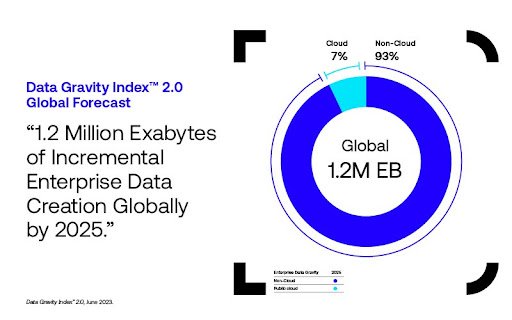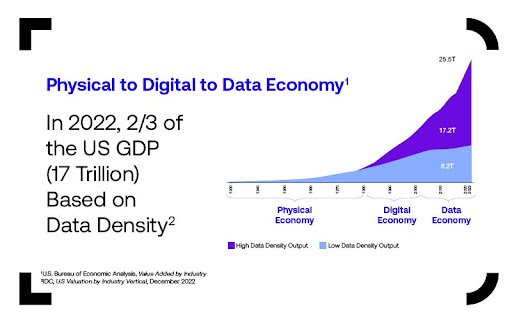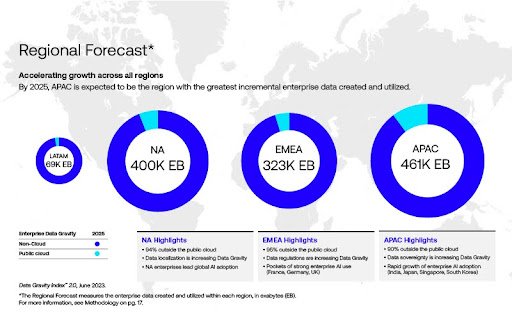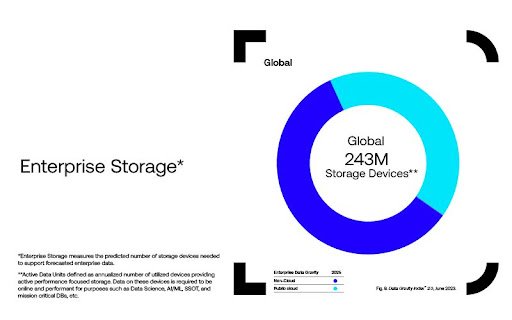Since the release of the Data Gravity Index™ 1.5 in 2020, we've witnessed the explosive growth of data creation globally. In recent years, global economies transformed from physical-powered to digital-powered. And now, we are in the next phase, transforming to become ‘data-powered’ – with high density data fueling economic growth.
This explosive data growth increases Data Gravity, which means that as more data is created and shared, the speed at which we can transmit that data decreases – increasing ‘gravity’ as a result.
As businesses of all sizes innovate to create better goods, services, and customer experiences, understanding how quickly data creation and utilization grows becomes a competitive edge to plan for infrastructure and capacity needs.
Digital Realty published recent findings in the Data Gravity Index™ 2.0, derived from one billion operations against over 100 million data point across more than 190 countries and 500 metros.
The Data Gravity Index™ 2.0 forecasts that global enterprise data creation will reach 1.2 million exabytes in the next three years. Ninety-three percent of this data will be created outside of the public cloud.
The growth of data among public cloud and private data centers represents a significant shift in how data is created, processed, stored, and exchanged. To keep up, enterprises must build a data-centric architecture to seize the $100+ trillion opportunity at hand.
Additionally, there are three key insights from the Data Gravity Index™ 2.0 that business leaders should takeaway:
1) As trade flows, data flows
Since its inception, the global economy has depended on the physical movement of people, goods, and services across geographic regions. We saw the evolution of the physical economy to a digital economy with the advancement of digital transformation.
And now, the data economy stems from the abundance of data created from digital interactions. The physical locations at the center of trade are also now the centers of enterprise data creation, processing, and exchange.
Enterprise data creation and Data Gravity are correlated with gross domestic product (GDP). As the GDP of a location rises, so does its data. The correlation between GDP growth and Data Gravity means multinational companies should establish a new architecture that puts data at the center. This new architecture brings the system to the user.
2) Secular trends drive data exchange
According to the Data Gravity Index™ 2.0, 1.2 million exabytes of incremental enterprise data will be created in the next three years, most of which happening outside of the public cloud.
Major population centers create and exchange the most data. As a result, this is where Data Gravity grows the fastest. Three macro trends centralized in metropolitan areas drive the propagation of Data Gravity, they include:
- Mergers and acquisitions
- Data regulations
- Maturity of digital technology adoption
According to McKinsey, “companies with flexible, adaptive architectural platforms are less likely to experience post-merger integration difficulties.” However, mergers and acquisitions increase digital workflows that propagate Data Gravity. And, as Data Gravity increases, special consideration should be given to how infrastructure and data sets are deployed and connected.
Data sovereignty, residency, and regulation requirements around the globe also drive Data Gravity's increase. In North America; Europe, Middle East, and Africa (EMEA); and Asia Pacific (APAC), Data Gravity intensity grows in all environments, mirroring the global increase. APAC leads the way in Data Gravity growth, with 461K exabytes created in the next three years.
In all three regions, 90 percent or more of data processing and usage will exist outside of the public cloud.
Enterprises located in major population centers lead innovation with their use of analytics, Artificial Intelligence (AI), and Big Data initiatives. To accommodate the data economy-led world, enterprises must be proactive in their capacity, deployment, and connectivity plans.
3) As data grows, infrastructure capacity grows
Multi-cloud and hybrid cloud adoption is becoming more common, which is contributing to the rise of Data Gravity.
According to the Data Gravity Index™ 2.0, 243 million incremental storage devices, evenly split between public and private on-premises storage, will be required to address enterprise Data Gravity. These storage devices must be cloud adjacent, as growth will occur between the cloud and the Edge.
In enterprise compute, data processing is going to occur outside of the public cloud and require 15.3 million incremental servers in the next three years.
This is significant capacity growth all around the world that impacts how business leaders think about and plan for their infrastructure capacity to accommodate data-intensive industries. Companies that capitalize on new product growth and profitability around data-first strategies will win.
It's time to prioritize ‘data first’ architecture
In today's data-driven landscape, businesses face the impact of Data Gravity head on. As they adopt data-centric approaches and calibrate their capacities, they strive to stay ahead in an interconnected world where data is at the core of every decision.
To dive deeper into Data Gravity insights and forecasts, download the Data Gravity Index™ 2.0 today.
More from Digital Realty
-

Digital Realty rolls out AI energy management platform in Asia Pacific
Apollo AI is helping data center giant cut power costs
-

Digital Realty and Mitsubishi open 34MW data center in Inzai City, Japan
Adds capacity to existing campus
-

Sponsored Reflections on 2023 and looking at the year ahead
Reflecting on the achievements and lessons learned in 2023 and how the industry is building on the past as we plan for the future





